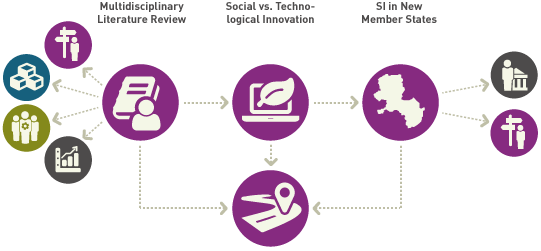Middle-range Theorising
Background
Researching the economic underpinnings of social innovation spans many academic disciplines. Establishing the theoretical foundation, therefore, requires an integrated approach to bridging relevant disciplines and insights. Moreover, the crosscutting nature and relational complexity of social innovation necessitates a systemic perspective on social innovation. In this sense, cross-sector cooperation (business, public and civil society) and networks are key success factors for social innovation and a key element of the theoretical foundation of the economic dimensions of social innovation. New and better approaches to creating social and economic value emerge precisely at these intersections through the exchange and combination of distinctive ideas, resources, capabilities and values, shifts in roles and relationships of actors, as well as the integration of private capital with public and philanthropic support.
Objectives
SIMPACT will develop a theory of middle-range that combines evolutionary thinking and modern policy science approaches within an understanding of the economic underpinnings of social innovation. The theoretical framework explains where and why social innovation takes root in specific contexts. It will enhance understanding of the drivers and enablers that stimulate, resource and sustain social innovation,including the policy and regulatory interventions that establish windows of opportunity for social innovators to create real economic and social value. The framework will be grounded in an understanding of the specific ways in which the relevant markets, public sectors and institutions function.
Methodology
Middle-range theorising provides a conceptual bridge between generalising from small-scale empirical studies and large-scale grand theories. Unlike theories, middle-range theories (MRT) focus on clearly defined topics, making explicit efforts to hybridise concepts, to search for abstract patterns and new explanatory mechanisms (Merton, 1968). Such an approach makes it possible to consider the specific nature of social innovations as interactive, generative and contextualised phenomena while maintaining that many practices at the micro-level can add up to patterns and regularities at the macro-level. MRT will, on the one hand, lay the ground for the main lines of theoretical and conceptual argumentation within SIMPACT. On the other hand it will substantiate theoretical advancements towards a multidisciplinary perspective on the economic dimensions of social innovation, identifying the direction of future empirical inquiries. Through an iterative process the theorising exercise will be informed by new evidence collected in the project's empirical work package go to WP(WP3).

- Task 1.1 - Multidisciplinary Literature Review learn more
- Task 1.2 - Interplay of Social and Technological Innovation learn more
- Task 1.3 - Social Innovation in New Member States learn more
- Task 1.4 - Theoretical Foundation of the Economics of SI learn more
Basic Information
-
Coordinator
IAT -
Contact
Judith TERSTRIEP -
Involved Partners
NEOMA, SIN, CIS, TNO, UM-MERIT, UBATH, NORD -
Start date
01/2014
Glossary
- 1
Middle-range Theory (MRT)
MRT was developed in sociology by Robert K. Merton in the late 1940s as a way of connecting high-level social theory with empirically observable patterns. As such it stands between high-level social theory (e.g. hermeneutics) and low-level general laws or principles.












